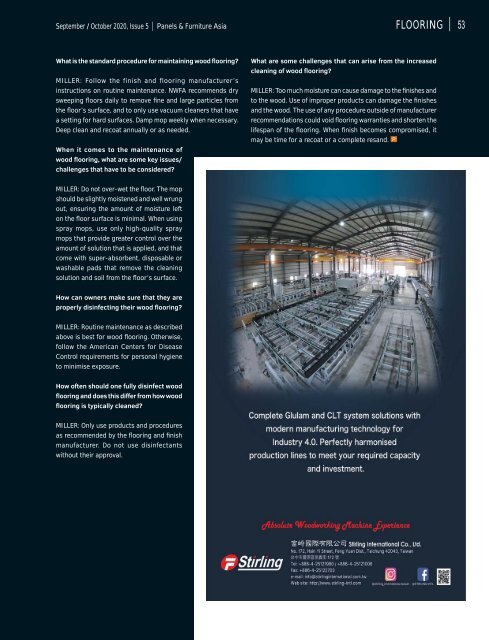Panels & Furniture Asia September/October 2020
Panels & Furniture Asia (PFA) is a leading regional trade magazine dedicated to the woodbased panel, furniture and flooring processing industry. Published bi-monthly since 2000, PFA delivers authentic journalism to cover the latest news, technology, machinery, projects, products and trade events throughout the sector. With a hardcopy and digital readership comprising manufacturers, designers and specifiers, among others, PFA is the platform of choice for connecting brands across the global woodworking landscape.
Panels & Furniture Asia (PFA) is a leading regional trade magazine dedicated to the woodbased panel, furniture and flooring processing industry. Published bi-monthly since 2000, PFA delivers authentic journalism to cover the latest news, technology, machinery, projects, products and trade events throughout the sector. With a hardcopy and digital readership comprising manufacturers, designers and specifiers, among others, PFA is the platform of choice for connecting brands across the global woodworking landscape.
Create successful ePaper yourself
Turn your PDF publications into a flip-book with our unique Google optimized e-Paper software.
<strong>September</strong> / <strong>October</strong> <strong>2020</strong>, Issue 5 | <strong>Panels</strong> & <strong>Furniture</strong> <strong>Asia</strong> FLOORING | 53<br />
What is the standard procedure for maintaining wood flooring?<br />
MILLER: Follow the finish and flooring manufacturer’s<br />
instructions on routine maintenance. NWFA recommends dry<br />
sweeping floors daily to remove fine and large particles from<br />
the floor’s surface, and to only use vacuum cleaners that have<br />
a setting for hard surfaces. Damp mop weekly when necessary.<br />
Deep clean and recoat annually or as needed.<br />
When it comes to the maintenance of<br />
wood flooring, what are some key issues/<br />
challenges that have to be considered?<br />
What are some challenges that can arise from the increased<br />
cleaning of wood flooring?<br />
MILLER: Too much moisture can cause damage to the finishes and<br />
to the wood. Use of improper products can damage the finishes<br />
and the wood. The use of any procedure outside of manufacturer<br />
recommendations could void flooring warranties and shorten the<br />
lifespan of the flooring. When finish becomes compromised, it<br />
may be time for a recoat or a complete resand. P<br />
MILLER: Do not over-wet the floor. The mop<br />
should be slightly moistened and well wrung<br />
out, ensuring the amount of moisture left<br />
on the floor surface is minimal. When using<br />
spray mops, use only high-quality spray<br />
mops that provide greater control over the<br />
amount of solution that is applied, and that<br />
come with super-absorbent, disposable or<br />
washable pads that remove the cleaning<br />
solution and soil from the floor’s surface.<br />
How can owners make sure that they are<br />
properly disinfecting their wood flooring?<br />
MILLER: Routine maintenance as described<br />
above is best for wood flooring. Otherwise,<br />
follow the American Centers for Disease<br />
Control requirements for personal hygiene<br />
to minimise exposure.<br />
How often should one fully disinfect wood<br />
flooring and does this differ from how wood<br />
flooring is typically cleaned?<br />
MILLER: Only use products and procedures<br />
as recommended by the flooring and finish<br />
manufacturer. Do not use disinfectants<br />
without their approval.


















